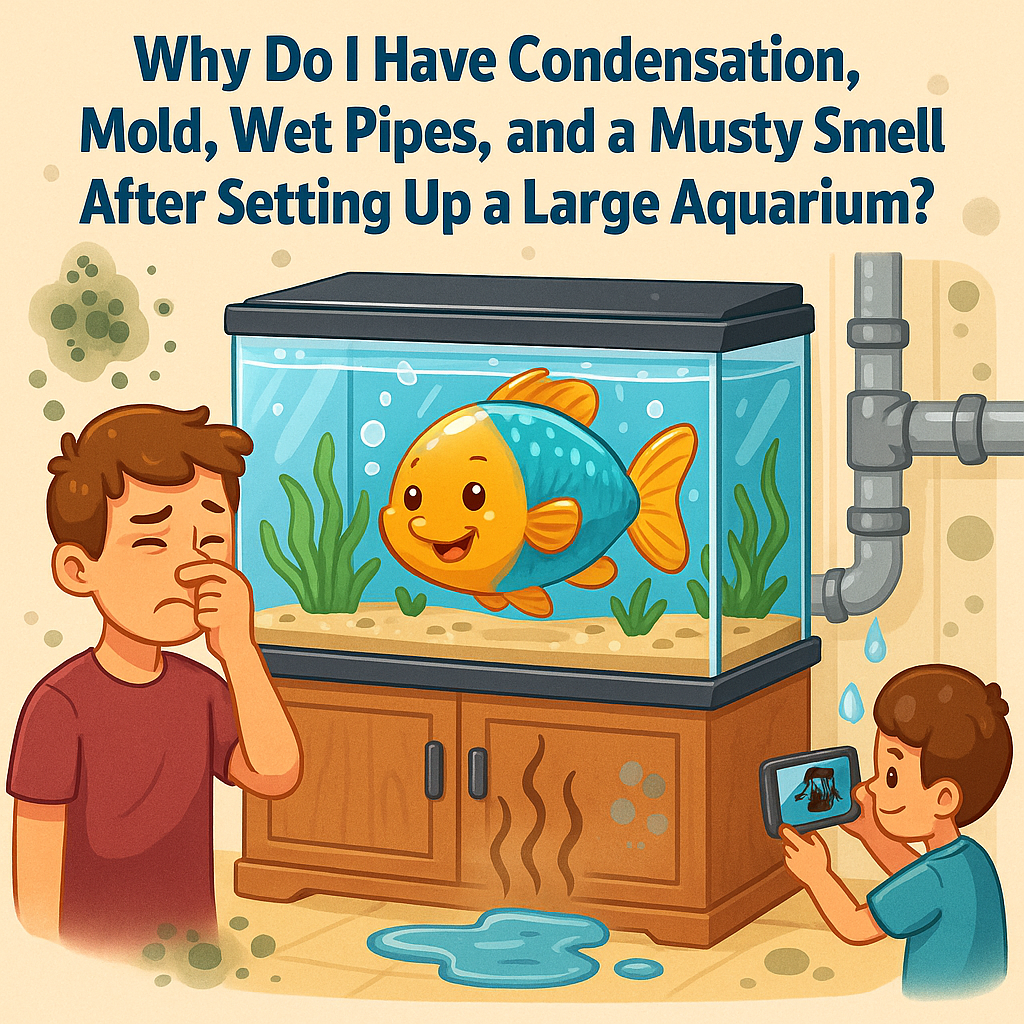Why Do I Have Condensation, Mold, Wet Pipes, and a Musty Smell After Setting Up a Large Aquarium?
💧 Why Do I Have Condensation, Mold, Wet Pipes, and Musty Smell After Setting Up a Large Aquarium?
🌡️ The Root Cause: Extra Moisture in the Air
- 🐟 Aquarium Evaporation – A large tank can evaporate 1–5 gallons of water daily, depending on size, lighting, and temperature.
- 💨 Trapped Moisture – Without enough ventilation, this water vapor builds up indoors.
- 🪟 Condensation Surfaces – Moisture condenses on cold windows, walls, and pipes.
- 🌱 Ideal Environment for Mold – High humidity creates perfect conditions for mold, mildew, and bacteria growth.
🚩 Signs You’re Experiencing Humidity Issues
- 🪟 Foggy Windows & Condensation – Water droplets pooling on glass, leading to warped frames or peeling paint.
- 🧱 Mold on Walls & Ceilings – Black, green, or white spots in corners, behind tanks, or near windows.
- 🚿 Sweaty Pipes – Cold-water pipes dripping onto floors or drywall.
- 👃 Musty Odor – Strong earthy smell from mold and mildew spores.
- 🧾 Increased Utility Bills – Excess humidity makes HVAC systems work harder.
⚠️ Risks to Watch Out For (Safety First!)
- 🏚️ Structural Damage – Water-damaged drywall, warped wood, weakened insulation, and rusted frames.
- ⚡ Electrical Hazards – Condensation around outlets, heaters, and lights can cause short circuits or even fires.
- 🤧 Health Concerns – Mold spores can trigger allergies, asthma, and respiratory infections.
- 🦠 Bacterial Growth – High humidity encourages harmful bacteria, dangerous if you have kids, elderly, or immunocompromised family members.
- 🐠 Tank Instability – If excess condensation drips back into tanks, it can alter water chemistry or introduce contaminants.
✅ Solutions: How to Fix and Prevent Humidity Issues
💨 Ventilation & Air Movement
- Install a dedicated exhaust fan in the fish room or near aquariums.
- Run ceiling fans or oscillating fans to prevent stagnant humid air.
- Crack windows slightly or use air exchange systems to balance airflow.
💧 Humidity Control
- Use a dehumidifier rated for your total tank room size.
- Monitor with a hygrometer—keep humidity between 40–50%.
- Cover tanks with glass lids or acrylic canopies to limit evaporation.
🪟 Insulation & Surface Protection
- Apply window insulation film during cold months.
- Wrap cold-water pipes with foam pipe insulation.
- Use mold-resistant paint on walls near aquariums.
🧼 Cleaning & Mold Management
- Wipe condensation daily with microfiber cloths.
- Clean mold early with vinegar, hydrogen peroxide, or diluted bleach.
- Dispose of heavily damaged materials (drywall, carpets, insulation).
🔒 Extra Safety Measures
- ⚡ Electrical Safety
- Always use GFCI outlets for aquarium equipment.
- Keep drip loops on all cords.
- Never run extension cords under tanks where condensation can drip.
- 🪑 Room Setup Safety
- Place aquariums on waterproof mats or trays to catch spills.
- Use vent covers with filters to prevent mold spores from spreading through HVAC ducts.
- Do not overcrowd tanks in one small room without proper airflow—risk multiplies.
- 🧯 Emergency Planning
- Keep a small shop vac handy for sudden water leaks or condensation puddles.
- Have a fire extinguisher near the fish room (electrical-rated).
- If humidity starts to cause visible mold growth, treat it seriously—long-term exposure can be dangerous.
🌟 Final Thought
Your aquarium brings life and beauty, but a large tank changes your home’s climate. By combining ventilation, dehumidification, insulation, and safety practices, you can protect your house, your health, and your fish.
Remember: 🐟 We love our aquariums, but safety always comes first—both for your pets and your family.
🐟 Fish Room Safety & Humidity Control Checklist
✅ Daily Checks
- 🪟 Wipe condensation from windows, walls, and tank lids.
- 💧 Check hygrometer – keep humidity 40–50%.
- ⚡ Inspect cords and power strips for moisture.
- 🐠 Ensure aquarium lids/canopies are properly sealed.
🔄 Weekly Tasks
- 💨 Empty & clean dehumidifier tank (if not on a drain hose).
- 🌀 Run fans and confirm airflow is circulating.
- 🧼 Clean mold-prone areas with vinegar or mild bleach solution.
- 🚿 Check pipes and walls for “sweating” or water spots.
- 📏 Inspect stand and flooring for signs of water damage.
🏠 Monthly Maintenance
- 🪛 Test GFCI outlets for safety shutoff.
- 🧯 Check fire extinguisher (electrical-rated, ABC).
- 🛠️ Inspect HVAC vents and replace filters (keeps mold spores out of air system).
- 🎛️ Confirm dehumidifier & fans are working at proper capacity.
- 🖼️ Inspect insulation film on windows and foam wraps on pipes.
🔒 Safety Setup Must-Haves
- ⚡ Electrical Protection
- Drip loops on all cords.
- Use GFCI outlets for pumps, heaters, and filters.
- No extension cords under or behind tanks.
- 💧 Water & Spill Safety
- Place aquariums on waterproof mats or trays.
- Keep a shop vac or mop nearby for emergencies.
- Store towels and buckets in the fish room.
- 🛡️ Mold Prevention
- Use mold-resistant paint near aquariums.
- Run an air purifier with HEPA filter.
- Clean spills immediately.
- 🚨 Emergency Preparedness
- Keep an ABC fire extinguisher close to the fish room.
- Have a battery-powered air pump for power outages.
- If mold spreads beyond small patches, call a remediation professional.

Powered by Lightspeed
Display prices in:USD